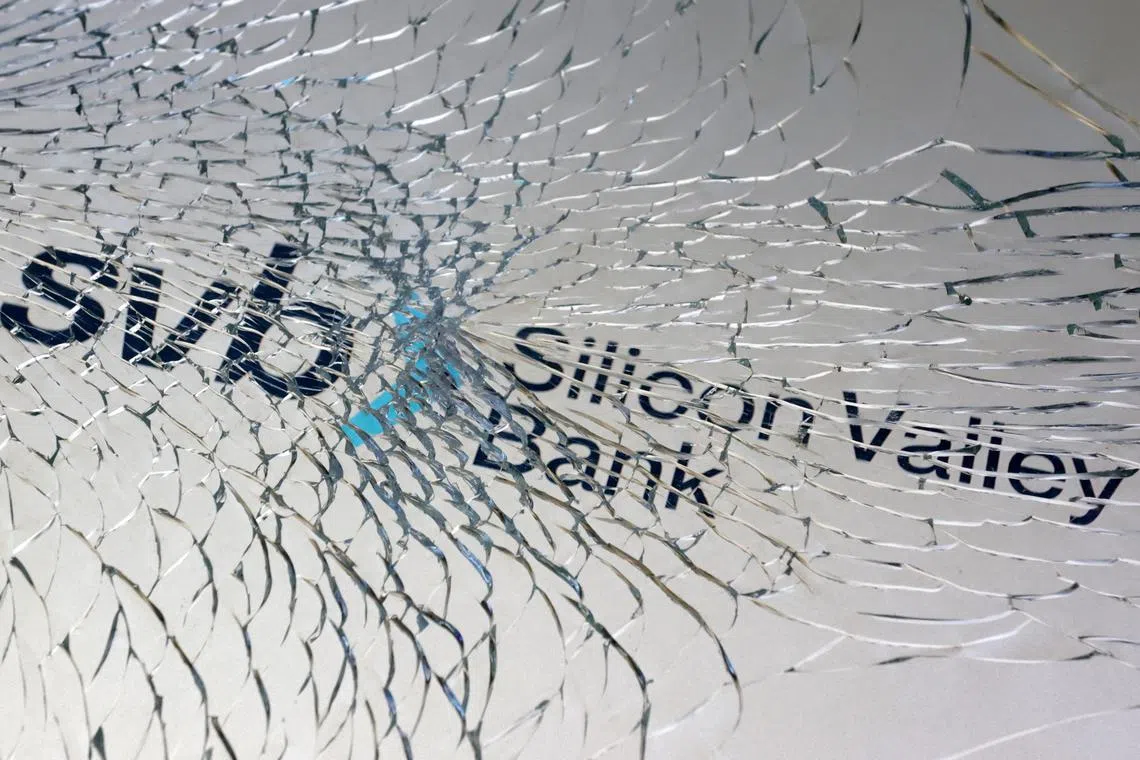Volatile day for Asia markets as US authorities act to limit fallout of bank collapse
Sign up now: Get ST's newsletters delivered to your inbox

Silicon Valley Bank collapsed under the weight of a massive bank run as it struggled to raise funds.
PHOTO: REUTERS
Follow topic:
SINGAPORE – Asian markets opened to a volatile Monday session, first rising as US stock futures rallied amid moves by the US authorities to limit contagion from the failure of two banks, then pulling back later in the day.
After initially trying to pare losses to within 0.7 per cent in early trading, the Straits Times Index slid by the end of its Monday session
Japan’s Nikkei 225 declined 1.1 per cent and Australia’s S&P/ASX 200 gave up 0.5 per cent, while South Korea’s Kospi index rose 0.7 per cent.
Also closing higher were Hong Kong and China markets.
The Hang Seng Index rallied almost 2 per cent, while the Shanghai Composite added 1.2 per cent.
Some within the market attributed this to China’s decision to retain its central banker and finance minister – two experienced hands – following its Cabinet reshuffle.
European markets opened mostly in the red, while Wall Street futures were mixed as Asia closed.
All this, after California-based Silicon Valley Bank (SVB) collapsed last Friday
Then on Sunday, US regulators shuttered New York-based Signature Bank for similar reasons.
The Federal Deposit Insurance Corporation (FDIC) stepped in on Sunday with funds to backstop depositors, while the US Federal Reserve offered loans to institutions impacted by the collapse of SVB and the weekend shutdown of Signature Bank.
Under the FDIC’s programme, individual deposits of up to US$250,000 (S$337,000) are insured and protected.
Meanwhile, HSBC stepped in to offer a symbolic £1
Some in the market also took heart from a Goldman Sachs report, which said the likelihood of a rate hike next week was remote, given the regional banking crisis in the United States.
While refusing to rescue the banks, the US Treasury, FDIC and the Fed have acted to protect depositors and customers of these and other regional banks that are at risk, thus to some extent preventing a systemic risk and contagion.
“Today, we are taking decisive action to protect the US economy by strengthening public confidence in our banking system,” said a joint statement from Fed chairman Jerome Powell, Treasury Secretary Janet Yellen and FDIC chairman Martin Gruenberg.
Goldman Sachs, in a report, said that in the light of the current stress on the banking system, it no longer expects the Fed’s Federal Open Market Committee (FOMC) to deliver a rate hike at its next meeting on March 22.
“We have left unchanged our expectation that the FOMC will deliver 25 basis-point hikes in May, June and July, and now expect a 5.25 per cent to 5.5 per cent terminal rate, though we see considerable uncertainty about the path,” it said.
Dow Jones futures were up 1.2 per cent, while S&P 500 futures jumped 1.6 per cent in early Asian trading. But both had weakened by the time Asian markets closed.
Market insiders do not see a direct impact on Singapore companies from the US regional bank meltdown.
“I think the impact here is minimal from SVB. Mostly start-ups may be affected, but they are mostly funded by equity not large banks like the Singapore banks,” noted Mr Thilan Wickramasinghe, regional head of research at Maybank.
That said, brokers see market sentiment remaining soft as nerves have been badly frayed since last Friday.
Separately, Maybank Securities downgraded Singapore banks to “neutral”, citing rising non-performing loan risks and tapering growth due to potential net interest margin squeeze.
But in a report, it maintained DBS Bank as its top pick.


